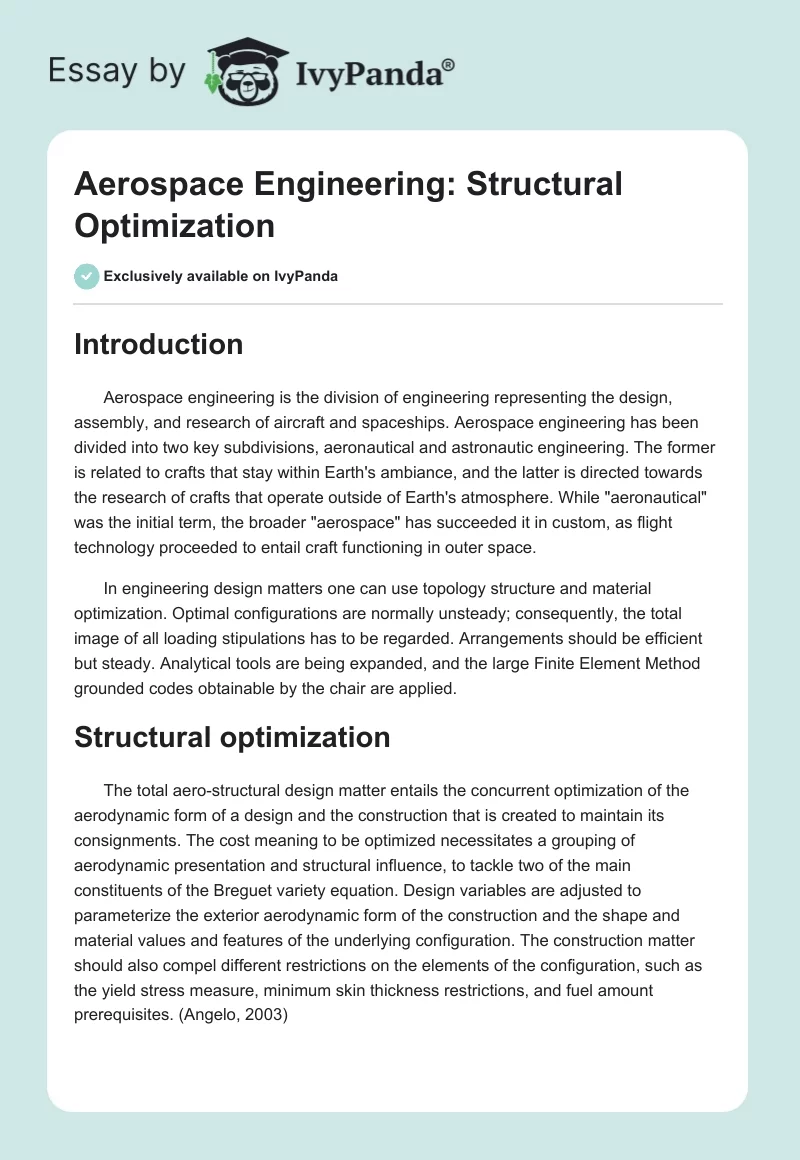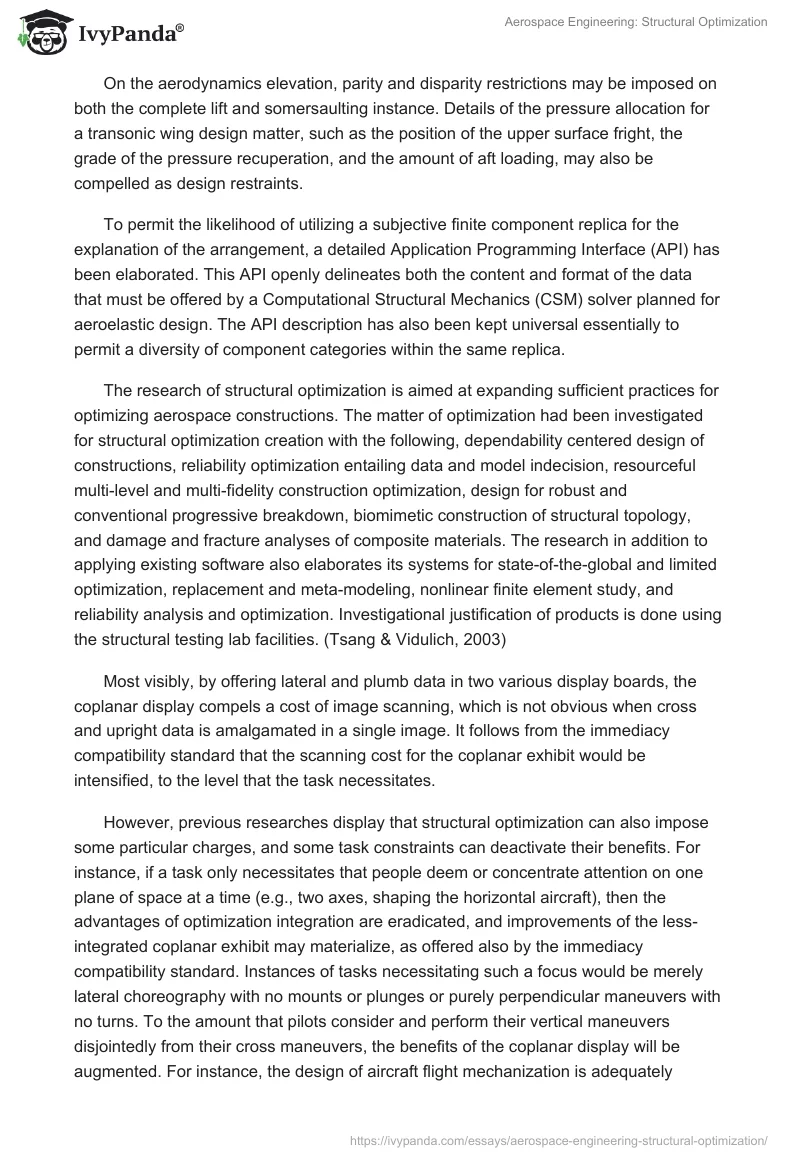Introduction
Aerospace engineering is the division of engineering representing the design, assembly, and research of aircraft and spaceships. Aerospace engineering has been divided into two key subdivisions, aeronautical and astronautic engineering. The former is related to crafts that stay within Earth’s ambiance, and the latter is directed towards the research of crafts that operate outside of Earth’s atmosphere. While “aeronautical” was the initial term, the broader “aerospace” has succeeded it in custom, as flight technology proceeded to entail craft functioning in outer space.
In engineering design matters one can use topology structure and material optimization. Optimal configurations are normally unsteady; consequently, the total image of all loading stipulations has to be regarded. Arrangements should be efficient but steady. Analytical tools are being expanded, and the large Finite Element Method grounded codes obtainable by the chair are applied.
Structural optimization
The total aero-structural design matter entails the concurrent optimization of the aerodynamic form of a design and the construction that is created to maintain its consignments. The cost meaning to be optimized necessitates a grouping of aerodynamic presentation and structural influence, to tackle two of the main constituents of the Breguet variety equation. Design variables are adjusted to parameterize the exterior aerodynamic form of the construction and the shape and material values and features of the underlying configuration. The construction matter should also compel different restrictions on the elements of the configuration, such as the yield stress measure, minimum skin thickness restrictions, and fuel amount prerequisites. (Angelo, 2003)
On the aerodynamics elevation, parity and disparity restrictions may be imposed on both the complete lift and somersaulting instance. Details of the pressure allocation for a transonic wing design matter, such as the position of the upper surface fright, the grade of the pressure recuperation, and the amount of aft loading, may also be compelled as design restraints.
To permit the likelihood of utilizing a subjective finite component replica for the explanation of the arrangement, a detailed Application Programming Interface (API) has been elaborated. This API openly delineates both the content and format of the data that must be offered by a Computational Structural Mechanics (CSM) solver planned for aeroelastic design. The API description has also been kept universal essentially to permit a diversity of component categories within the same replica.
The research of structural optimization is aimed at expanding sufficient practices for optimizing aerospace constructions. The matter of optimization had been investigated for structural optimization creation with the following, dependability centered design of constructions, reliability optimization entailing data and model indecision, resourceful multi-level and multi-fidelity construction optimization, design for robust and conventional progressive breakdown, biomimetic construction of structural topology, and damage and fracture analyses of composite materials. The research in addition to applying existing software also elaborates its systems for state-of-the-global and limited optimization, replacement and meta-modeling, nonlinear finite element study, and reliability analysis and optimization. Investigational justification of products is done using the structural testing lab facilities. (Tsang & Vidulich, 2003)
Most visibly, by offering lateral and plumb data in two various display boards, the coplanar display compels a cost of image scanning, which is not obvious when cross and upright data is amalgamated in a single image. It follows from the immediacy compatibility standard that the scanning cost for the coplanar exhibit would be intensified, to the level that the task necessitates.
However, previous researches display that structural optimization can also impose some particular charges, and some task constraints can deactivate their benefits. For instance, if a task only necessitates that people deem or concentrate attention on one plane of space at a time (e.g., two axes, shaping the horizontal aircraft), then the advantages of optimization integration are eradicated, and improvements of the less-integrated coplanar exhibit may materialize, as offered also by the immediacy compatibility standard. Instances of tasks necessitating such a focus would be merely lateral choreography with no mounts or plunges or purely perpendicular maneuvers with no turns. To the amount that pilots consider and perform their vertical maneuvers disjointedly from their cross maneuvers, the benefits of the coplanar display will be augmented. For instance, the design of aircraft flight mechanization is adequately classified in terms of vertical routing and lateral navigation. The pilot just is not supplied with data to the side, above, below, and behind the aircraft, the data that could be significant for flight security, chiefly traffic on a conflict itinerary from the side, or in hostile combat surroundings. It is necessary to mention, that the extent of this “keyhole cost” will be augmented or reduced by decreasing or growing, correspondingly, the Geometric Field of View (GFOV) of the exhibit. (Warren & Wertheim, 2005)
An essential understanding of local optimization in aerospace structural construction with the optimal application of achievable software and the suitable selection of optimization algorithms has been attained. The likelihood exists for the future expansion of MSC.NASTRAN to integrate a parametric optimization ability and for interfacing MSC.NASTRAN with other optimization encloses to maintain the CRC-ACS research actions. Further work could either entail implementing the offered global optimization tactics or comprise implementing rapid techniques for classifying multiple local optimization strategies, such as trajectory ruled or homotopy systems into slope-grounded algorithms. (Angelo, 2003)
Conclusion
This construction surrounding has been used to execute RANS aeroelastic study of absolute arrangement flight and wind-tunnel replicas with an extra cost which is less than 10% of the cost of a customary rigid-geometry CFD decision. These decisions can be applied to conclude a priori whether essential aero elastic alterations will or will not be required for the resulting wind warren information.
Lastly, a structural pressure penalty purpose was added to the coefficient of drag of the absolute pattern to permit the exclusion of artificial breadth restrictions that are generally inflicted in aerodynamic form optimization practices. This elementary coupling of aerodynamics and constructions in the design not only eradicates the obligation to impose reproduction constrictions but also constructs designs where trade-offs among aerodynamic and structural presentation are regarded.
References
Angelo, J. A. (2003). Space Technology. Westport, CT: Greenwood Press.
Tsang, P. S. & Vidulich, M. A. (Eds.). (2003). Principles and Practice of Aviation Psychology. Mahwah, NJ: Lawrence Erlbaum Associates.
Warren, R. & Wertheim, A. H. (Eds.). (2005). Perception & Control of Self-Motion. Hillsdale, NJ: Lawrence Erlbaum Associates.


